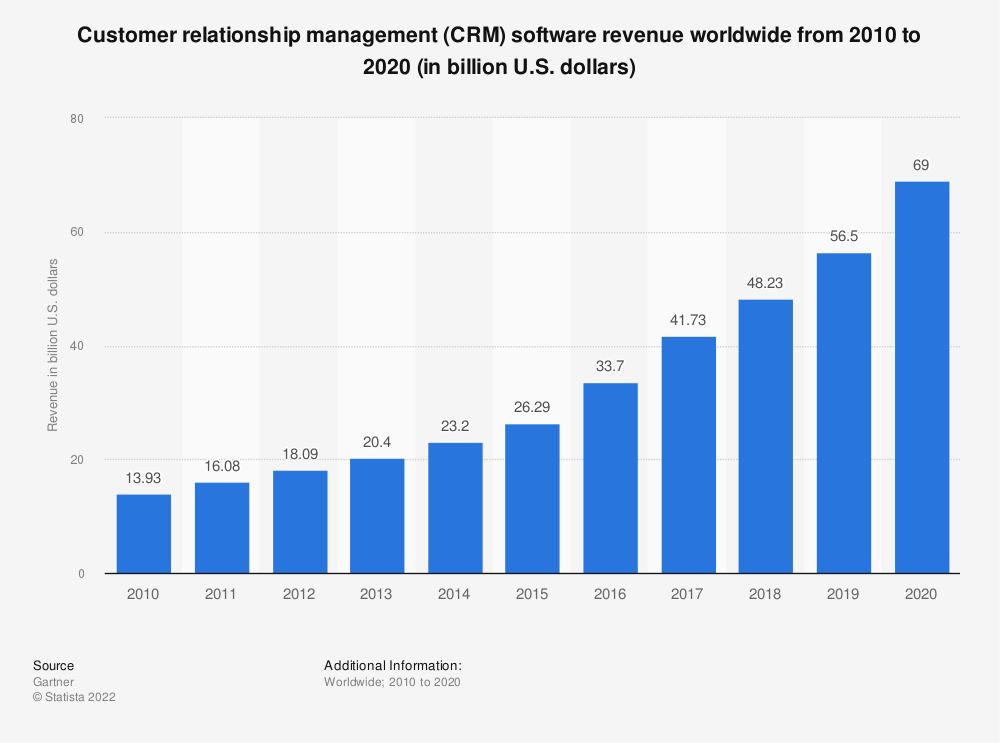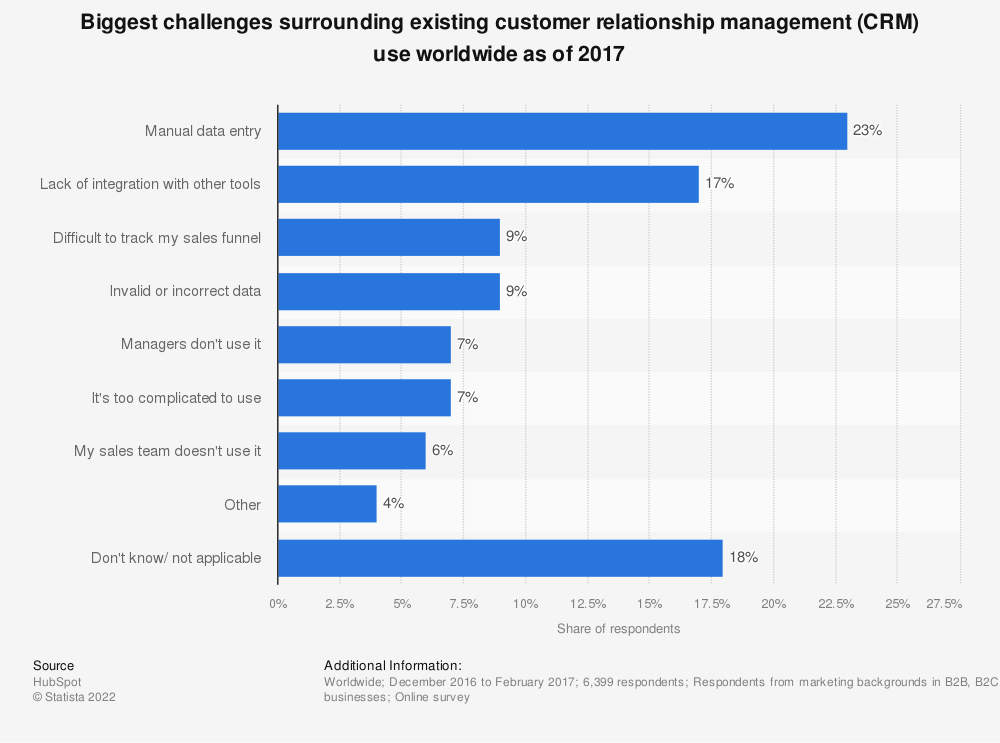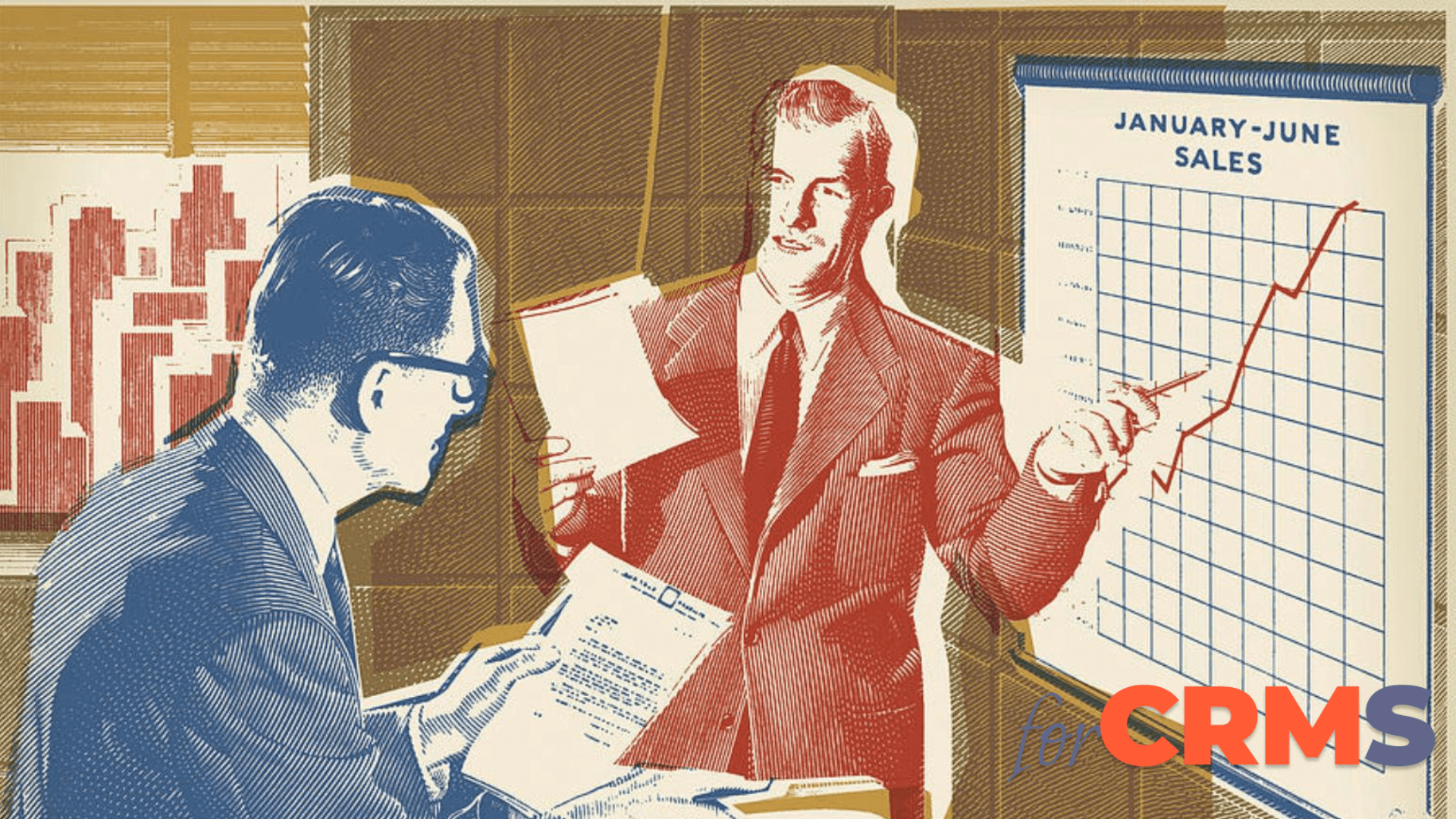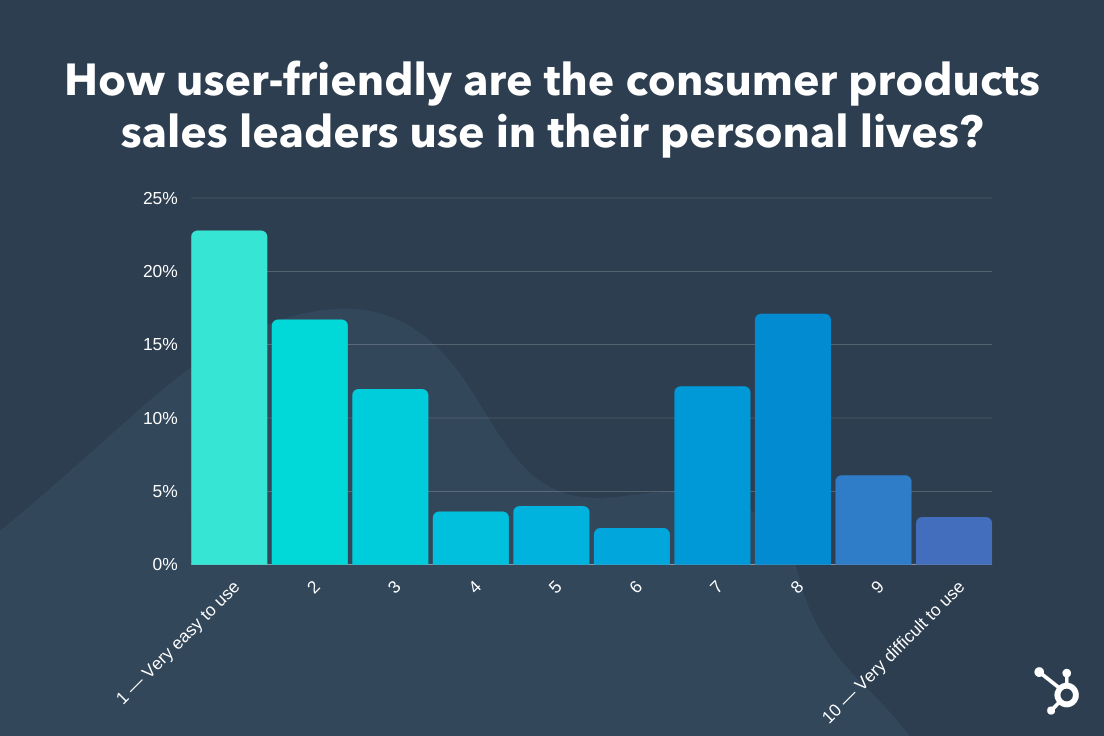In the past, before the pandemic took hold, business was conducted in person, with face-to-face meetings in bustling cafes and crowded meeting rooms. However, with the current situation, the business landscape has shifted towards online and remote operations. As a result, the importance of software and SaaS solutions has grown exponentially, acting as a crucial mediator between the now-remote minds and hands that drive the business world.
If you are a business owner or considering starting a company in today's day and age, it is essential to have a CRM solution in place. If you are unfamiliar with CRM, it is crucial to familiarize yourself with the basics first.
Furthermore, it is highly recommended to explore the following significant statistics, facts, and forecasts about CRM software and the future of the CRM industry. Understanding these numbers will enable you to plan your budget effectively when selecting the right CRM solution. Additionally, it will provide you with a head start on implementing the CRM successfully among your team.
These statistics and facts will serve as a solid foundation to educate yourself on the various benefits and barriers associated with total CRM implementation.
CRM adoption rate statistics
Statistics about CRM adoption rates refer to the number of people, companies and organizations who are using or plan to use a CRM solution. What we see with the below data is that CRM adoption has only one direction to go in, and that’s up.
12% - CRM adoption growth over the next 5 years
What does this CRM adoption statistic mean? It means that between now and 2028, the amount of businesses adopting a CRM system will steadily increase by 12%. This is regarding a figure known as compound annual growth rate, or CAGR, which means that each year the percentage increase applies to the previous year and not the initial figure when the increases began.
So what does this mean for your bottom line? Well, with a projected 12% growth in CRM adoption over the next 5 years, the value of the CRM industry is set to skyrocket to a staggering $129 billion dollars by 2028. But it's not just about the money. Implementing a CRM solution also leads to increased customer satisfaction, which in turn drives higher sales, profits, and return on investment. So investing in CRM software is not only a smart financial move, but also a strategic one for the overall success of your business.
$55 Billion - Increase in CRM revenue between 2010 and 2020
According to Statista, reporting on a study from Gartner, the revenue of CRM businesses has increased from just under $14 Billion US dollars in 2010, to about $69 Billion in 2020. That’s an increase of about $55 Billion, or in percentage terms, an increase of an impressive 393%.
This statistic isn’t exactly reflective of adoption. However, revenues by CRM platforms do offer a window into the rates of increase in the adoption of CRMs by businesses.

CRM solutions will make up the largest area of expenses in enterprise software
Remember, customer relationship management are far from the only business SaaS providers in the game. There are ERP apps, or enterprise resource management, as well as CMS, content management systems, and a range of other business acronyms.
CRM systems are actually newer than ERPs, so it’s not surprising that ERPs have historically sucked up the most money companies were spending on productivity software to boost business and increase profits.
But famed research and consulting firm Gartner, as reported on by business magazine leader Forbes, proposes that we are undergoing a shift, and that the best CRMs are poised to surpass ERPs.
Benefits to companies that use CRM
There are many benefits to companies that use CRM, mainly to get new customers, close more deals, and deepen customer loyalty. Because without constant and steadily increasing sales, a business can’t really survive in today’s competitive arenas.
$8.71 - Expected average ROI for every dollar spent on sales CRM software
Back in 2014, a popular study of the benefits of sales CRM solutions came to the conclusion that for every dollar a company spent on a CRM system, they could expect a return on investment (ROI) of about $8. Now, eight to one is a solid investment statistic, but those numbers need to be compared to what’s come before.
The last time this study was done in 2011, the ROI ratio was only $5.60 to one, which means we have a 38% increase in just a few years. More recent studies have predicted that in the future, that magical ROI figure can get up to as high as about 30 to 1.
This is surely because of the value added to a company via CRM when it comes to giving sales teams better tools for higher customer retention and being able to offer an overall better customer experience.
$1.1 Trillion - Revenue from CRM solutions that use artificial intelligence
Now, here's a CRM statistic straight from the CRM powerhouse and sales technology pioneer Salesforce. While we always encourage a healthy dose of skepticism, we trust that this data has been delivered in good faith.
These days, it's rare to find CRM software without some nifty AI sales tools and functionality. From automation and workflows to email marketing and lead acquisition, CRM solutions have truly evolved. So, this impressive CRM trend of over one trillion dollars is not something to scoff at. It goes to show that the old-school manual CRM advantage is now surpassed by the immense value provided by AI-powered solutions.
Improved customer experience - Top benefit of using CRM customer analytics
CRM solutions not only stand for customer relationship management but also represent a means for companies to deliver an exceptional customer experience. A Statista study conducted in 2018 in the USA revealed that 85% of CRM users expected their CRM system to enhance the overall customer experience. Following closely behind, 58% of respondents believed that CRMs facilitate faster decision-making, while 54% highlighted the benefits of streamlined operations. Additionally, 53% of participants emphasized the importance of improved collaboration between sales, marketing, service, and operations departments when using CRM software.
Other benefits lower on the list include introducing new business models or products, increased innovation, and finally, CRMs help businesses be more competitive in the digital sphere.
CRM users & usage statistics
This set of statistics is about the numbers of CRM users both in general and within organizations. It’s important to look at CRM usage as a separate factor than CRM subscriptions and sales, because even though a company may purchase CRM software, it doesn’t mean everyone there is using it or all its features to the maximum potential.
91% - Percentage of companies with 10 or more employees who use CRM
It should be obvious that the top sales priorities are not doing administrative tasks like data entry. Rather, sales teams need to focus on what matters: finding new customers, getting more opportunities into the sales cycle, and focusing on ways to increase sales and blast through sales quotas.
So what does this CRM statistic say really, since it seems that most salespeople spend a bit less than one fifth of their day on a CRM platform or actively using their CRM features?
It says there is room to improve, and we’ll surely start seeing that percentage go up with the popular adoption of mobile CRM, more streamlined functionality around workflow automation, and tighter sales funnel management.
Lead generation and customer retention - Largest use of CRM by application
By now we all know that CRMs are way more than complex spreadsheets for customer data management systems. They have many different applications, ranging from marketing tools, to sales features, to customer support and service tools.
However, this Fortune Business Insights statistic shows us that the most common applications of CRMs are still for sales, that is, getting new leads and keeping customers happy by providing a great customer experience.
These applications make up about 32% of CRM usage. Going down the list after lead generation is customer support, contact management, automations like for email marketing, and then other tools like social media marketing and brand management.
Statistics on CRM barriers to entry and use challenges
While CRMs are getting easier to buy, onboard, and use, there are always some problems that cause some CRM barriers to entry. These statistics demonstrate some of those problems, along with other challenges or using a CRM platform.
50% - Percentage of sales managers who say CRM is difficult to implement
This CRM statistic comes from inbound marketing giant HubSpot, which also offers a wealth of software advice and data on their blog. This statistic may seem a bit troubling: after all, half is half no matter how large your sales team is.
The fact that half of all sales leaders and managers openly admit that CRM implementation is a problem is a huge barrier for companies and sales reps to be able to take advantage of these sales process optimization tools.
The good news is that CRM software is improving regarding ease of use, becoming more affordable and more customizable with every year. Now, you even have free online CRM and desktop options and open source CRM to choose from. We hope to see this percentage drop as barriers to CRM entry slacken.
<40% - Percentage of CRMs that have full-scale adoption in a company
There are many reasons why a company that implements a CRM fails to get everyone on board and fully taking advantage of the tools and features to boost sales productivity. According to this one study reported on by CRM solution SuperOffice, there are several reasons for this.
They are as follows: The technology actually only counts for part of this problem, according to 35% of people asked. 40% of people asked think it's a strategy and deployment issue.
Most importantly, 42% of people who were asked about why less than 40% of CRM implementations are fully successful said the problem was with people, that is, companies did not have CRM implementation experts or properly train their sales managers to help their teams with CRM onboarding.

Manual data entry - Biggest challenge using CRM
This statistic is less about barriers to entry and more about barriers to full and proper CRM usage.
What these figures, reported on by Statista from a HubSpot in-depth study of inbound marketing, show is that 23% of people say that manual data entry is one of the main barriers of beginning to use a CRM or challenges of using one regularly.
At 17%, the next barrier and challenge is a lack of integration with other tools.
After that, other barriers and challenges listed include sales funnel tracking difficulties, bad data, a lack of adoption or use by the managerial class, and of course, there is the barrier that it is (or seems) too complicated, though only 7% of those surveyed gave that answer.


CRM market share statistics
The customer relationship management market share competition is getting fiercer by the year, both in terms of CRMs competing with other SaaS, as well as between different industries. CRM comparison statistics help us understand what’s really going on.
CRM market size in 2022 – Greater than $47 Billion
Statistic website Statista is the source for this highly impressive figure. This is the total worldwide market size of CRM as calculated in US dollars. That number has gone up from $24 Billion back in 2015, and $45 Billion from 2020.
The same source is also willing to put their forecast accuracy to the test by predicting the future market size of CRM across the globe. They say by 2025 it will be close to $50 Billion.
This projection demonstrates a compound annual CRM software market growth rate of 1.7% between 2020 and the 2025 forecast, or in dollar terms, almost $5 Billion dollars.
If you could put a dollar amount to the value of great customer data, then these statistics show how important customer data is now and will continue to be in the future.

Salesforce - Leading CRM vendor since 2016
This is one more set of statistics brought to you by Statista. It covers the market share divisions by some of the biggest names in CRM and business software. These vendors include Salesforce, SAP, Oracle, Microsoft Dynamics 365, Adobe, and others.
From 2016 until 2020, Salesforce has consistently maintained its position as the leading CRM vendor, capturing a significant portion of the market share. Throughout these years, Salesforce's market share ranged from 16.8% in 2018 to 19.6% in 2017. In the most recent year, Salesforce secured a market share of 19.5%, highlighting its continued dominance in the CRM industry.
Following closely behind Salesforce in the rankings are SAP and Oracle, both of which have consistently vied for the second position. Microsoft and Adobe entered the scene in 2017, making their mark in the CRM market. However, they have yet to reach the same level as Salesforce, SAP, and Oracle, with each of them never quite hitting the 5% mark in terms of market share.
These statistics underline the competitive landscape of the CRM market and highlight the ongoing success of Salesforce as the leading CRM vendor. As the market continues to evolve, it will be interesting to see how these dynamics shift and whether new players will emerge to challenge the established leaders.

Professional services - Largest CRM market share by industry
According to a study by Apps Run The World and reported on by Statista, the largest market share for industry-specific CRM goes to professional services, covering close to 30% of the CRM market. This is based on Salesforce’s data.
Professional services refer to highly skilled career people who often need some official certification to do their jobs, like lawyers, accountants, medical professionals, engineers, IT specialists and teaching professionals.
Next on the list is the manufacturing sector, at about 12%, then banking and financial services at roughly 9%, and finally, retail at about 8%.
However, it is in sectors like retail, especially ecommerce, where CRM is poised to become more and more dominant. This is also valid for industries like leisure, hospitality, restaurants and other personalized entertainment services.
Other CRM facts
3:1 - Ratio of sales reps who meet their quotas using a mobile CRM compared to those who do so without
Every good piece of SaaS these days needs to have some presence on mobile devices. Often, the web browser version is responsive to different screen sizes and adapts when accessed with a laptop, tablet or mobile device.
Some CRMs have dedicated mobile CRM apps which can be downloaded from the Apple App Store or the Google Play Store.
This statistic shows that sales reps who use mobile CRMs, they meet their sales quotas about 66% of the time, while sales reps who do not use mobile CRMs only hit their target sales numbers 22% of the time.
That’s a three-to-one ratio, and one not to be scoffed at if you are a salesperson needing to crush those conversion rates and get those bonuses.
Social media monitoring - Most desired new CRM feature
This statistic might seem a bit old and outdated, but still there are some useful insights in there (it’s from 2015). The results of this study featured in Statista show that social media monitoring was the most wanted new tool to be part of a CRM kit, getting 25% of this vote.
Just behind it at 24% is the ability to pull in new leads off of social media profiles, something a few of the best CRMs now do. Following these features are: having a mobile app, customer loyalty tracking, e-commerce integration, and territory assignment.
How to use these CRM research figures: Our conclusion
In addition to the resources mentioned, there are countless other online platforms and research studies that provide a wealth of CRM research and statistics. However, we have taken the time to thoroughly review and compare these sources to bring you the most comprehensive and insightful collection of key CRM statistics. These statistics cover a wide range of areas, including CRM adoption rates, growth, revenue, and more.
The overarching conclusion that can be drawn from all of this data is that CRM is poised for continued growth and increasing importance. It is not only expected to gain more market share but also to penetrate new industries and sectors. This trend has been further accelerated by the COVID-19 pandemic, as businesses recognize the necessity of CRM tools not only for sales teams but also for marketers and support agents.
Behind all the numbers and figures lie the customers themselves, who are at the heart of every business. The data consistently points to the fact that CRM is crucial for enhancing customer satisfaction. As a result, the demand for more advanced and effective CRM solutions will only continue to grow. Businesses are constantly striving for better CRM systems that can meet the evolving needs of their customers, ultimately leading to improved customer experiences and long-term success.
So, whether it's about increasing adoption rates, driving revenue growth, or enhancing customer satisfaction, the message is clear: businesses need to invest in CRM and strive for the best CRM solutions available. With the right CRM platform in place, businesses can effectively streamline their processes, improve sales productivity, and build stronger relationships with their customers. The future of CRM is undoubtedly bright, and it is crucial for businesses to embrace this powerful tool to stay ahead in today's competitive landscape.




%201.png)


.png)